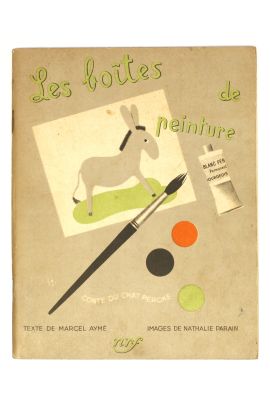| Author | Marcel Aymé |
|---|---|
| Signed | No |
| Publisher | Librairie Gallimard |
| Publishing date | 1941 |
| Language | French |
| Edition | First edition |
| Binding | Softcover |
| Book condition | Collectible; Very Good |
| Condition description | minor toning to paper, faint earmark front cover, some rust on staples, else fine |
| Cover condition | Very good |
| Dimensions (cm hxb) | 23x18 |
The Evolution of Youth Publishing at Gallimard
Early Beginnings
1908-1930s: Gallimard's initial foray into publishing children's books started modestly between 1919 and 1930, marked by a handful of progressive but limited publications. It wasn't until the mid-1930s that Gallimard made a significant push in this area, spurred by competitive publishers and evolving market dynamics.
Post-War Era and Further Development
Post-World War II: This period saw experimental and tentative steps in children's publishing at Gallimard. Noteworthy contributions came from Pierre Marchand, who brought innovative direction to Gallimard Jeunesse.
Early Publications and Challenges
Initial Challenges: Gallimard's first children's book, "Macao et Cosmage" by Edy-Legrand (1919), faced commercial challenges, indicating the complexities of the children's book market.
Strategic Shifts and Key Personalities
Mid-1930s Onwards: The company saw a strategic shift with more focused efforts in children's literature. Key figures like Brice Parain, influenced by Russian children's books, and others played a crucial role in shaping Gallimard's approach.
Post-War Expansion and Consolidation
1940s and Beyond: The post-war era marked a period of expansion and consolidation in Gallimard's children's book publishing. This period was characterized by experimentation, diversification, and a focus on literary quality.
The Rise of Gallimard Jeunesse
Creation of Gallimard Jeunesse: Under the guidance of Pierre Marchand, Gallimard Jeunesse emerged as a distinct entity, specializing in high-quality children's literature and encompassing various genres and formats.
Notable Authors and Illustrators
The text references several prominent authors and illustrators who contributed to Gallimard's success in children's publishing, including Antoine de Saint-Exupéry ("The Little Prince"), Nathan Altman, and others.
Modern Era Developments
1970s and Onwards: The modern era saw further innovation and growth in Gallimard's children's publishing, with new series and collaborations, cementing its reputation in the industry.
The narrative provides an in-depth look at the challenges, milestones, and key figures that shaped Gallimard's journey in establishing a successful children's book publishing arm, reflecting the broader trends and transformations in the literary world.
Marcel Aymé, born on March 29, 1902, in Joigny and died on October 14, 1967, at his home on rue Norvins in the 18th arrondissement of Paris, was a French writer, playwright, short story writer, screenwriter, and essayist. A prolific author, he wrote two essays, 17 novels, several dozen short stories, about ten plays, over 160 articles, and tales. He remained very attached to his region of origin, Franche-Comté, which he prominently featured in his novels: "La Table aux crevés" (1929) for which he won the Renaudot Prize, "La Vouivre" (1941), and "Gustalin" (1938). However, he became a true "Parigot" (a Parisian), as he wrote about Paris and not about Franche-Comté, where he was originally from. In his works, he depicted various social classes of Paris including the working class ("La Rue sans nom"), the lower middle class ("Le Bœuf clandestin" in 1939), intellectuals and snobs ("Travelingue" in 1941). Through these writings, he provided a "social study", using precise vocabulary for each type of character. His language mixed different registers: slang, regional Franche-Comté dialect, formal French, and phonetically Frenchified English. Criticized by reviewers, even for his most harmless texts like "Les Contes du chat perché", he owed much of his success to the public. In theater, his stand against the death penalty in "La Tête des autres" (1952) sparked strong reactions and enthusiasm, as did his biting comedies: "Lucienne et le Boucher" (1948) and "Clérambard" (1950). He also wrote numerous screenplays and translated important American authors: Arthur Miller ("The Crucible") and Tennessee Williams ("The Night of the Iguana"). Many films, TV movies, and cartoons have been adapted from his works. Cultivating his status as a politically marginal writer, he remained very distant from intellectual circles, leading him to be classified first as a leftist writer, then a rightist, and finally as a right-wing anarchist.
Children books
Les Boîtes de Peinture
€125.00
A book from 'Les Contes du Chat Perché' series with text by Marcel Aymé and color images by Nathalie Parain, regarded as one of the most beautiful books for children.
Part of the series 'Les Contes du Chat Perché', includes stories like LE PAON, LE MOUTON, LES CYGNES, among others.
In stock
